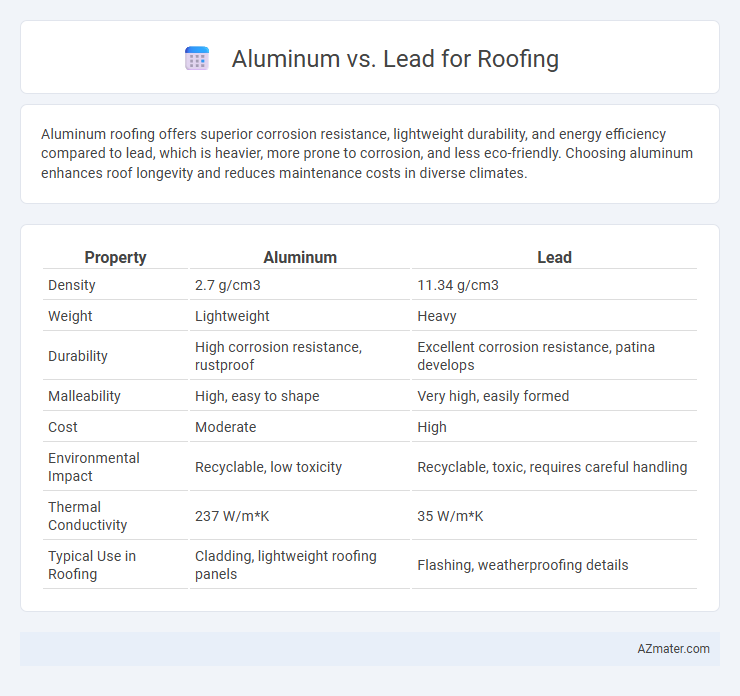Aluminum roofing offers superior corrosion resistance, lightweight durability, and energy efficiency compared to lead, which is heavier, more prone to corrosion, and less eco-friendly. Choosing aluminum enhances roof longevity and reduces maintenance costs in diverse climates.
Table of Comparison
| Property | Aluminum | Lead |
|---|---|---|
| Density | 2.7 g/cm3 | 11.34 g/cm3 |
| Weight | Lightweight | Heavy |
| Durability | High corrosion resistance, rustproof | Excellent corrosion resistance, patina develops |
| Malleability | High, easy to shape | Very high, easily formed |
| Cost | Moderate | High |
| Environmental Impact | Recyclable, low toxicity | Recyclable, toxic, requires careful handling |
| Thermal Conductivity | 237 W/m*K | 35 W/m*K |
| Typical Use in Roofing | Cladding, lightweight roofing panels | Flashing, weatherproofing details |
Introduction to Aluminum and Lead Roofing
Aluminum roofing offers lightweight durability, exceptional corrosion resistance, and energy efficiency due to its reflective properties, making it a popular choice in residential and commercial buildings. Lead roofing, known for its malleability and longevity, provides excellent waterproofing and has been traditionally used in historic and heritage structures for centuries. Both materials differ significantly in weight, environmental impact, and maintenance requirements, influencing their suitability for various roofing applications.
Material Properties: Aluminum vs Lead
Aluminum roofing offers superior corrosion resistance, lightweight durability, and high reflectivity compared to lead, which is much heavier and prone to oxidation despite its malleability. Aluminum's tensile strength and low thermal expansion make it ideal for varied climates, while lead's density provides excellent sound insulation but can cause structural strain over time. The environmental impact also favors aluminum due to its recyclability and lower toxicity relative to lead, which poses health risks during fabrication and disposal.
Durability and Lifespan Comparison
Aluminum roofing offers superior corrosion resistance and typically lasts 40 to 70 years due to its lightweight and rust-proof properties, making it ideal for various weather conditions. Lead roofing, known for its exceptional durability and malleability, can endure over 100 years, often surpassing aluminum in lifespan but requires more maintenance to prevent oxidation. Choosing between aluminum and lead depends on balancing longevity with maintenance needs, where lead excels in lifespan but aluminum provides a cost-effective, low-maintenance alternative.
Weather Resistance and Performance
Aluminum roofing offers superior weather resistance due to its natural corrosion resistance, lightweight properties, and excellent ability to withstand extreme temperatures and moisture without rusting. Lead, while traditionally durable with high malleability, is prone to oxidation and can develop a patina that may compromise its long-term waterproofing effectiveness. Aluminum's performance in coastal and snowy environments surpasses lead, making it a preferred choice for roofing in climates with harsh weather conditions.
Installation Process Differences
Aluminum roofing is lightweight and flexible, making it easier and faster to cut, shape, and install compared to lead, which is significantly heavier and requires more precise handling to avoid damage. Lead roofing demands skilled labor due to its malleability and the need for specialized tools to form seams and joints properly, whereas aluminum can be installed with standard roofing tools and techniques. The faster installation time of aluminum often results in reduced labor costs and project duration compared to the complex and time-intensive installation process of lead roofing.
Maintenance Requirements
Aluminum roofing requires minimal maintenance due to its corrosion resistance and lightweight properties, reducing the risk of rust and structural damage over time. Lead roofing, while durable and long-lasting, demands regular inspections and maintenance to prevent oxidation and potential softening, especially in areas with high humidity. Choosing aluminum can lead to lower maintenance costs and longer intervals between repairs compared to lead roofing.
Environmental Impact and Sustainability
Aluminum roofing offers superior environmental benefits due to its high recyclability, lightweight nature, and energy efficiency in production compared to lead. Lead roofing poses significant environmental hazards because of its toxicity and limited recyclability, leading to soil and water contamination risks. The sustainable choice favors aluminum for reducing ecological footprint and promoting long-term resource conservation in roofing applications.
Cost Analysis: Aluminum vs Lead Roofing
Aluminum roofing generally costs between $120 and $350 per square, making it a more affordable option compared to lead roofing, which can range from $250 to $500 per square due to lead's higher material and installation expenses. Aluminum offers long-term savings with its corrosion resistance and lightweight properties that reduce structural support needs, while lead's durability and malleability come with increased upfront and maintenance costs. Choosing between aluminum and lead roofing depends largely on budget constraints and the desired longevity and aesthetic preference for the roofing project.
Aesthetic and Design Considerations
Aluminum roofing offers a modern, sleek appearance with its smooth finish and is available in a wide range of colors and styles, providing versatile design options for contemporary architecture. Lead roofing, while traditional and historic, features a natural patina that develops over time, lending a timeless, classic aesthetic particularly suited to heritage buildings. The lightweight nature of aluminum allows for more creative architectural designs without compromising structural support, whereas lead's heavier weight limits design flexibility but enhances durability and weathering charm.
Choosing the Right Roofing Material for Your Project
Aluminum offers lightweight durability and excellent corrosion resistance, making it ideal for long-lasting roofing in coastal or humid environments, while lead provides superior malleability and weatherproofing, especially beneficial for complex roof shapes and historic restorations. Considering factors such as climate, roof design, budget, and maintenance requirements helps determine the optimal material; aluminum typically requires less upkeep and is more cost-effective, whereas lead excels in traditional craftsmanship applications but involves higher initial costs and environmental considerations. Selecting the right roofing material depends on balancing performance characteristics with project-specific needs to ensure durability, aesthetics, and compliance with building standards.

Infographic: Aluminum vs Lead for Roofing
 azmater.com
azmater.com